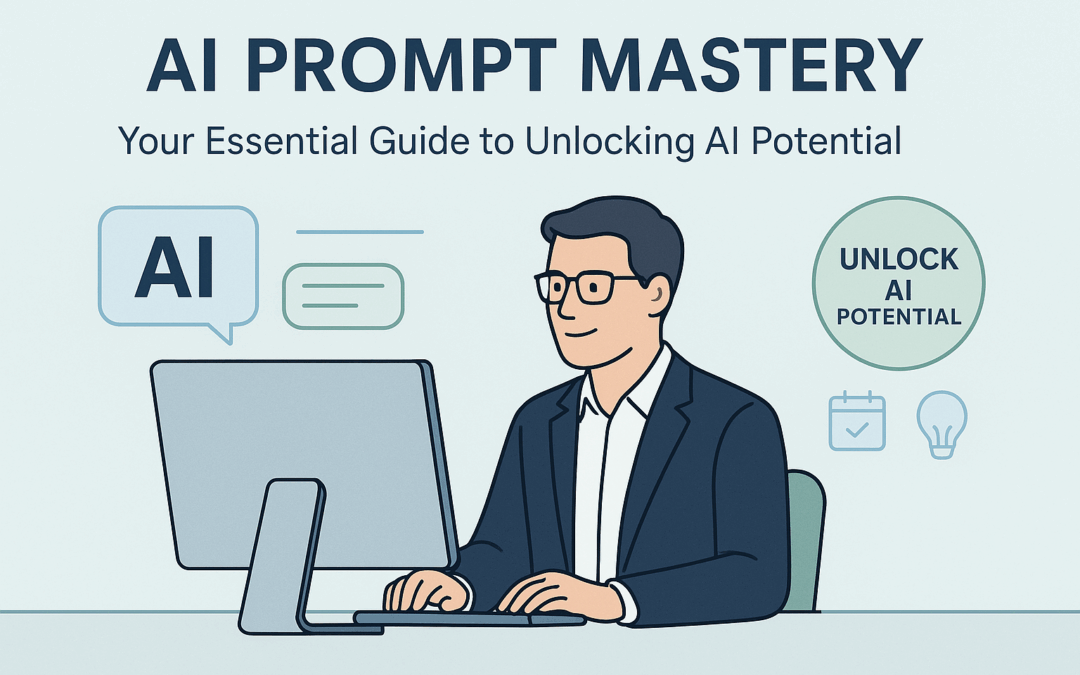AI Prompt Mastery: Your Essential Guide to Unlocking AI Potential
Transform how you interact with AI. This guide provides a concise, visual roadmap to effective prompt engineering, ensuring you get the most out of every AI interaction.
Why Prompt Mastery Matters: The “Garbage In, Garbage Out” Principle
Clear Prompts, Quality Outputs
AI is highly literal. Precise instructions yield relevant results. Vague inputs lead to vague outputs.
- Optimized Outputs: Get precisely what you need, faster.
- Enhanced Efficiency: Streamline tasks, automate workflows.
- Deeper Insights: Leverage AI for advanced analysis.
- Reduced Bias: Guide AI for accurate, ethical information.
Core Principles: Build Strong AI Foundations
These universal principles are your roadmap to effective AI communication.
💬 Clarity & Conciseness
Read More
- The Golden Rule: Be crystal clear about what you want. Avoid ambiguity, jargon, and overly complex sentence structures. Simple, direct language works best.
- Action Verbs: Use strong action verbs to define the desired AI behavior (e.g., “Summarize,” “Generate,” “Analyze,” “Categorize,” “List,” “Compare”).
- Cite Your Source: Google’s AI Prompt Engineering Playbook: Top 10 prompt tips – YourStory.com (April 14, 2025) emphasizes keeping it simple and using action verbs. Microsoft Learn’s AI Builder prompt engineering guide (February 24, 2025) also stresses clear and concise language.
🎯 Specificity & Detail
Read More
- Avoid Vagueness: Don’t just say “Write a blog post.” Instead, specify the topic, target audience, tone, length, key points to include, and any formatting requirements.
- Context is King: Provide sufficient background information to guide the AI in generating relevant and coherent responses. Think of it as setting the stage for a productive conversation.
- Cite Your Source: Google’s Playbook (April 14, 2025) strongly advises being super specific. OpenAI’s “Best practices for prompt engineering with the OpenAI API” (May 18, 2025, based on a related Reddit discussion) also highlights the importance of being specific, descriptive, and detailed about context, outcome, length, format, and style.
✅ Instructions Over Constraints
Read More
- Tell it What to Do, Not What Not to Do: AI models generally respond better to positive instructions. Instead of saying, “Don’t use technical terms,” say, “Explain in simple terms suitable for beginners.”
- Cite Your Source: Google’s Playbook (April 14, 2025) found that AI tools tend to provide biased responses when given limitations. Anthropic’s Claude 4 prompt engineering best practices (September 2024 PDF) explicitly states, “Tell Claude what to do instead of what not to do.” OpenAI also recommends saying what to do instead of what not to do.
📏 Manage Output Length & Format
Read More
- Define Boundaries: Explicitly state the desired length (e.g., “Respond in 3 bullet points,” “a 300-word explanation”).
- Specify Format: Request answers in specific formats like bullet points, numbered lists, tables, JSON, or prose paragraphs.
- Cite Your Source: Google’s Playbook (April 14, 2025) and Anthropic’s Claude 4 best practices (September 2024 PDF) both emphasize specifying the output format.
Advanced Techniques: Master AI Interactions
Elevate your prompting skills for more powerful results.
✨ Few-Shot Prompting
Read More
- Show, Don’t Just Tell: Provide one or more examples of the desired input/output behavior within your prompt. This allows the model to learn and mimic the characteristics of the results.
- Cite Your Source: Google’s AI Prompt Engineering Best Practices: 12 Key Techniques from 2025 White Paper (April 14, 2025) highlights providing examples as a key technique. IBM’s Prompt Engineering Guide (May 7, 2025) also details few-shot and one-shot prompting. Anthropic (September 2024 PDF) and OpenAI (May 18, 2025) also recommend this.
🧠 Chain-of-Thought (CoT)
Read More
- Think Step-by-Step: For complex tasks requiring reasoning or multi-step problem-solving, instruct the AI to “think step-by-step” or break down the problem into smaller, logical steps. This encourages the AI to generate intermediate reasoning steps before providing the final answer.
- Cite Your Source: IBM’s Prompt Engineering Guide (May 7, 2025) details Chain-of-Thought prompting as a crucial technique for complex tasks. Reddit discussions on Automatic Chain-of-Thought (January 23, 2025) also mention it as an advanced technique.
🎭 Role-Playing
Read More
- Assign a Persona: Instruct the AI to act as a specific persona (e.g., “You are a seasoned medical professional,” “You are a marketing expert for small businesses,” “Act as a career coach”). This helps the AI adopt a relevant tone, style, and knowledge base.
- Cite Your Source: Anthropic’s Best Practices for Prompt Engineering (September 2024 PDF) suggests assigning Claude a role (System Prompts). Godofprompt.ai’s Complete Guide For Meta Prompting (May 13, 2025) also recommends deciding on a role for ChatGPT.
🔄 Iterative Refinement
Read More
- It’s a Conversation: Prompt engineering is rarely a one-shot process. Start with a basic prompt, evaluate the output, and then refine your prompt based on the results. This iterative feedback loop is crucial for optimizing AI performance.
- Cite Your Source: IBM’s Prompt Engineering Guide (May 7, 2025) emphasizes iterative refinement, and HealthTech Magazine (April 15, 2025) states that “Trial and error is a critical part of prompt engineering.”
🤖 Meta Prompting
Read More
- Prompting the Prompt: Use AI to help you create better prompts. Ask the AI to optimize your existing prompts for clarity, efficiency, or specific outcomes.
- Cite Your Source: Godofprompt.ai’s Complete Guide For Meta Prompting (May 13, 2025) and Hacker News discussions (June 3, 2025) highlight this emerging technique.
Tailored Prompting: AI for Your Unique Needs
Customize AI to excel in your specific domain.
🏥 For Healthcare Providers
Focus: Clinical decision support, research summarization, patient education, administrative efficiency.
Key Considerations & Sources
- Specificity: Define patient demographics, symptoms, conditions, and desired output (e.g., “Summarize three possible treatment plans for a 55-year-old male diagnosed with Type 2 diabetes, limiting each to 300 words, using only peer-reviewed sources and highlighting potential drug interactions.”).
- Context: Provide detailed medical context.
- Guardrails: Instruct AI to cite sources, identify uncertainties, and never provide medical advice directly.
- Role: “You are a highly experienced medical research assistant.”
- Cite Your Source: HealthTech Magazine’s “Prompt Engineering in Healthcare: Best Practices, Strategies & Trends” (April 15, 2025) and ResearchGate’s “Prompt-Eng: Healthcare Prompt Engineering” (May 3, 2025).
📈 For Upskillers
Focus: Learning new skills, career development, portfolio content, interview preparation.
Key Considerations & Sources
- Learning Objectives: Clearly state what you want to learn or practice.
- Format: Request explanations, step-by-step guides, practice scenarios, or quizzes.
- Role: “You are an expert tutor in [specific skill],” or “Act as a mock interviewer for a [job title] position.”
- Cite Your Source: LinkedIn Learning’s “The Art and Science of AI Prompt Engineering” (undated). Times of India’s “8 ways prompt engineering can be your career lifeline in the age of AI” (June 5, 2025).
💼 For SMEs
Focus: Marketing content, customer support, business strategy, process optimization.
Key Considerations & Sources
- Business Goal: Align prompts with specific business objectives.
- Brand Voice: Specify desired tone and style.
- Target Audience: Clearly define your customers.
- Output Type: Request email campaigns, product descriptions, sales pitches, or strategic outlines.
- Cite Your Source: AIPRM’s “Effective Prompt Engineering for Small Businesses” (undated). Social Media Examiner’s “Prompt Engineering Fundamentals” (May 28, 2024). Sand Technologies’ “Prompt Engineering: An Emerging New Role in AI” (February 11, 2025).
⏱️ For Busy Individuals
Focus: Time management, quick summarization, drafting, personal organization.
Key Considerations & Sources
- Conciseness: Get straight to the point.
- Efficiency: Ask for summarized info or actionable lists.
- Templates: Create and reuse prompts.
- Output Format: Opt for bullet points, short paragraphs, or checklists.
- Cite Your Source: BusyQA’s “Artificial Intelligence with Prompt Engineering Training with Placement” (undated). “AI Prompt Engineering: A Beginner’s Handbook” (January 23, 2025). Reddit discussions on Adaptive Prompting (January 23, 2025).
The Future of Prompt Mastery: Continuous Learning & Adaptation
AI is constantly evolving. Stay ahead with these practices:
- Stay Updated: Regularly review resources from AI giants.
- Experiment: Continuously test new prompting strategies and observe their impact.
- Share & Learn: Engage with AI communities to discover best practices.
Unlock Your AI Potential Today!
This guide provides a foundational understanding of prompt mastery. By applying these principles and techniques, you will enhance your ability to interact with AI effectively and gain a significant competitive advantage.
Ready to transform your approach to AI?
Chager.org specializes in AI education and strategic consulting, offering tailored programs and expert guidance to help individuals and organizations harness the full power of artificial intelligence. Contact us today to learn more about our workshops, customized training, and strategic consulting services.
Chager.org
jchager@aisimplifynow.io
Assess Your AI Prompting Skills!
Answer a few questions to gauge your prompt engineering proficiency. Based on your responses, we'll provide personalized recommendations for further learning and tools.



Recent Comments